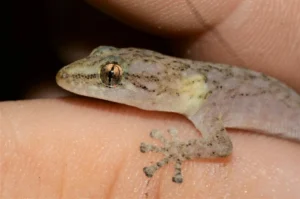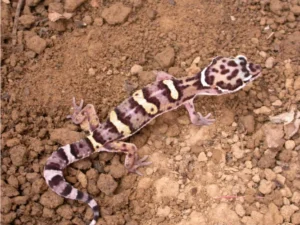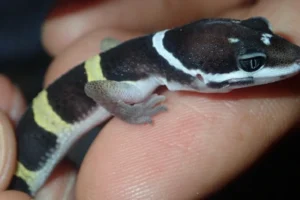If you’ve ever watched a gecko in a terrarium, you might see it basking under a warm light, then slipping into a cool corner. It makes you wonder, do geckos really need a heat lamp?
Yes, most geckos need a heat lamp to stay active, digest food properly, and stay healthy. Geckos are cold-blooded, which means they depend on outside warmth to control their body temperature. Without a heat source, they can become slow, stop eating, and even develop serious health problems.
Why Geckos Depend on External Heat
Geckos are reptiles, so they can’t make their own body heat like mammals. In the wild, they use the sun and warm surfaces to stay active.

Their movement, digestion, and even their immune system all depend on being warm enough.
If a gecko gets too cold, it becomes clumsy and sluggish. Hunting becomes harder, digestion slows, and it’s easier for them to get sick.
Warmth isn’t just comfort, it’s survival.
How Geckos Use Heat Naturally
In nature, geckos move between warm and cool areas all day. During the day, they might bask on sunlit rocks or walls.
At night, they stay in spots that hold gentle warmth so they can keep hunting.
If it gets too hot, they hide under leaves or inside crevices to cool off.
This constant movement between warm and cool areas is called behavioral thermoregulation, it’s how they keep their body working properly.
Do All Geckos Need the Same Temperature?
No, each species has different needs.
- Leopard geckos come from dry desert areas and need a warm side around 88–92°F (31–33°C) and a cooler side around 75–80°F (24–27°C).
- Crested geckos come from tropical forests and prefer cooler, more humid conditions around 75–82°F (24–28°C).
- Day geckos, which are active in sunlight, need higher temperatures.

Giving your gecko a range of temperatures in its tank is very important.
That way, it can move to where it feels most comfortable for resting, digesting, or being active.
How Geckos Use a Heat Lamp
A heat lamp in captivity acts like the sun in the wild.
Geckos might:
-
Bask under the lamp to warm up before eating or hunting.
-
Move away when they feel too hot.
-
Use the warmth to digest food better.
The lamp isn’t just light, it’s energy their bodies absorb to keep everything working. Without it, their health can slowly decline.
What Happens Without a Heat Lamp?
Without enough heat, geckos start to show small signs of stress:
-
They move less.
-
They hide a lot.
-
They refuse food.
-
Shedding slows down.
If it stays too cold, their digestion and immune system weaken, and illness can follow.
For example, a leopard gecko kept in a room that’s around 70°F (21°C) might stop eating and lose weight. That’s why warmth isn’t optional, it’s necessary.
Do Night-Active Geckos Need Heat Too?
Yes, even geckos that are active at night still need warmth.

They hunt after dark, but their body still needs heat to function. Night temperatures should be a little cooler than the day but still warm enough to be safe.
A gentle nighttime heat source, like an under-tank heater or a low-watt lamp, helps them stay active, digest food, and stay healthy.
How to Set Up the Perfect Heat Lamp
Setting up a heat lamp is easy if you follow a few simple rules:
-
Create a warm side and a cool side so the gecko can choose where to go.
-
Use thermometers on both sides to check the temperatures.
-
Avoid overheating, geckos can’t sweat, so too much heat is dangerous. Give them hiding spots to cool off.
-
Match the setup to your gecko’s species.
A good heat lamp setup doesn’t just warm the tank, it copies the natural environment where geckos thrive.
Do Geckos Need Heat All Year?
It depends on the species and where you live.
Tropical geckos might be fine all year if the room stays warm and humid. Desert species often need extra heat in cooler months to stay active.
Even indoors, temperatures can drop at night, so keeping a steady heat source helps your gecko stay healthy all year.
Heat Lamps vs. Other Heating Methods
Heat lamps aren’t the only way to keep geckos warm:
-
Under-tank heaters give gentle warmth from below, great for ground-dwelling species.
-
Ceramic heat emitters provide heat without light, useful for night-active geckos.
- Warm hides use heat pads to give geckos a cozy spot to warm up.

Sometimes, using more than one method works best. What matters most is giving your gecko the choice to move between warm and cool areas.
Signs Your Gecko Likes the Heat
You can tell when a gecko enjoys its heat lamp:
-
It rests under the light before eating.
-
It stretches out to soak up warmth.
-
It sheds smoothly.
-
It hunts actively at night.
These are all signs your heat setup is working well.
Can Too Much Heat Harm Geckos?
Yes, too much heat can be just as bad as too little.
If the enclosure gets too hot, geckos might:
-
Pant or move around restlessly.
-
Hide all the time.
-
Stop eating.
-
Lose their bright color.
A safe temperature range and good hiding spots fix this. Heat should help, not harm.
Heat Lamps and Breeding
Heat is very important for breeding. Female geckos need warmth to develop eggs, and baby geckos need steady temperatures to grow strong.
Without enough heat, eggs might not develop or hatchlings could be weak.
That’s why a heat lamp isn’t just for comfort, it helps support life itself.
Watching Your Gecko and Adjusting Heat
The best way to tell if your gecko’s heat setup is right is to watch it.
If it moves freely between warm and cool areas, it’s comfortable. If it avoids the heat or stays in one spot too long, something might need adjusting.
Geckos are great at showing us what they need, we just have to notice.
Conclusion
So, do geckos need a heat lamp?
Yes, most geckos depend on external heat to stay healthy, digest food, move properly, and even reproduce.
A good heat lamp copies the warmth of the sun, creating a safe, natural space for them to thrive.
Without heat, geckos slow down and their health quietly declines. With it, they stay alert, active, and full of life, just the way we love to see them.
Hi, my name is Ezra Mushala, i have been interested animals all my life. I am the main author and editor here at snakeinformer.com.

